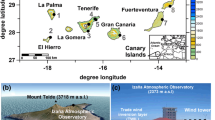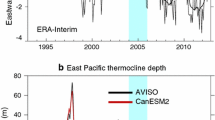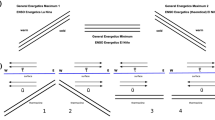Abstract
Using multiple surface wind speed (SWS) data sets and trend empirical orthogonal function analysis, we have explored the trend in SWS associated with the large-scale tropical Pacific atmospheric circulation for the period 1979–2001. The present research provides a robust evidence of strengthening of the tropical Pacific Ocean SWS during this period and the magnitude is generally in line with the finding of Wentz et al. The strengthening in SWS is closely associated with the so-called La Niña-like sea surface temperature (SST) trend pattern rather than the changes in the ENSO, ENSO Modoki, or PDO. The present results, together with those from some recent climate model simulations, suggest that global warming forcing may have caused an intensification of SWS in the tropical Pacific Ocean by inducing the La Niña-like SST trend pattern due to ocean dynamics. Meanwhile, the strengthening in the tropical Pacific Ocean surface trade winds may also feedback to enhance the La Niña-like SST trend pattern under the positive wind-upwelling dynamic feedback mechanism.












Similar content being viewed by others
References
Allan RP, Soden BJ (2007) Large discrepancy between observed and simulated precipitation trends in the ascending and descending branches of the tropical circulation. Geophys Res Lett 34:L18705. doi:10.1029/2007GL031460
Allen MR, Ingram WJ (2002) Constraints on future changes in the hydrological cycle. Nature 419:224–228
An SI (2003) Conditional maximum covariance analysis and its application to the tropical Indian Ocean SST and surface wind stress anomalies. J Clim 16:2932–2938
Andronova N, Penner JE, Wong T (2009) Observed and modeled evolution of the tropical mean radiation budget at the top of the atmosphere since 1985. J Geophys Res 114:D14106. doi:10.1029/2008JD011560
Ashok K, Yamagata T (2009) The El Niño with a difference. Nature 461:481–484
Ashok K, Behera SK, Rao AS, Weng H, Yamagata T (2007) El Niño Modoki and its teleconnection. J Geophys Res 112:C11007. doi:10.1029/2006JC003798
Barnosa SM, Andersen OB (2009) Trend patterns in global sea surface temperature. Int J Climatol 29:2049–2055
Bjerknes J (1969) Atmospheric teleconnections from the equatorial Pacific. Mon Wea Rev 97:163–172
Cane MA, Clement AC, Kaplan A, Kushnir Y, Pozdnyakov D, Seager R, Zebiak SE, Murtugudde R (1997) Twentieth-century sea surface temperature. Science 275:957–960
Chelton DB, Wentz FJ (2005) Global microwave satellite observations of sea surface temperature for numerical weather prediction and climate research. Bull Amer Meteor Soc 86:1097–1115
Chen J, Carlson BE, Genio ADD (2002) Evidence for strengthening of the tropical general circulation in the 1990s. Science 295:838–841
Chou SH, Nelkin E, Ardizzone J, Atlas RM, Shie CL (2003) Surface turbulent heat and momentum fluxes over global oceans based on the Goddard satellite retrievals, version 2 (GSSTF2). J Clim 16:3256–3273
Clement AC, Soden B (2005) The sensitivity of the tropical-mean radiation budget. J Clim 18:3189–3203
Clement AC, Seager R, Cane MA, Zebiak SE (1996) An ocean dynamical thermostat. J Clim 9:2190–2196
Collins M, Tett SFB, Cooper C (2001) The internal climate variability of HadCM3, a version of the Hadley Centre coupled model without flux adjustments. Clim Dyn 17:61–81
Daley R (1991) Atmospheric data analysis. Cambridge University Press, Cambridge, p 457
Ebuchi N, Graber HC, Caruso MJ (2002) Evaluation of wind vectors observed by QuikSCAT/SeaWinds using ocean buy data. J Atmos Oceanic Technol 19:2049–2062
Fairall CW, Bradley EF, Hare JE, Grachev AA, Edson JB (2003) Bulk parameterization of air–sea fluxes: updates and verification for the COARE algorithm. J Clim 16:571–591
Fang C, Wu L (2008) The role of ocean dynamics in tropical Pacific SST response to warm climate in a fully coupled GCM. Geophys Res Lett 35:L08703. doi:10.1029/2007GL033097
Gastineau G, Treut HL, Li L (2008) Hadley circulation changes under global warming conditions indicated by coupled climate models. Tellus Ser A 60:863–884
Hannachi A (2007) Pattern hunting in climate: a new method for finding trends in gridded climate data. Int J Climatol 27:1–15
Hansen J, Ruedy R, Sato M, Reynolds R (1996) Global surface air temperature in 1995: return to pre-Pinatubo level. Geophys Res Lett 23(13):1665–1668
Hansen J, Ruedy R, Glascoe J, Sato M (1999) GISS analysis of surface temperature change. J Geophys Res 104(D24):30997–31022. doi:10.1029/1999JD900835
Hansen J, Ruedy R, Sato M, Imhoff M, Lawrence W, Easterling D, Peterson T, Karl T (2001) A closer look at United States and global surface temperature change. J Geophys Res 106:23947–23963. doi:10.1029/2001JD000354
Hansen J et al (2005) Earth’s energy imbalance: confirmation and implications. Science 308:1431–1435. doi:10.1126/science.1110252
Hansen J, Sato M, Ruedy R, Lo K, Lea DW, Medina-Elizade M (2006) Global temperature change. Proc Natl Acad Sci USA 103:14288–14293
Hansen J, Sato M, Ruedy R, Lo K (2010) Global surface temperature change. Rev Geophys. doi:10.1029/2010RG000345
Held IM, Soden BJ (2006) Robust responses of the hydrological cycle to global warming. J Clim 19:5686–5699
Kalnay E et al (1996) The NCEP/NCAR 40-year reanalysis project. Bull Amer Meteor Soc 77(3):437–471
Kanamitsu M, Ebisuzaki W, Woollen J, Yang SK, Hnilo JJ, Fiorino M, Potter GL (2002) NCEP-DOE AMIP-II reanalysis (R-2). Bull Amer Meteor Soc 83(11):1631–1643
Kaplan A, Cane MA, Kushnir Y, Clement AC, Blumenthal MB, Rajagopalan B (1998) Analyses of global sea surface temperature 1856–1991. J Geophys Res 103(C9):18567–18589
Kim HM, Webster PJ, Curry JA (2009) Impact of shifting patterns of Pacific Ocean warming on North Atlantic tropical cyclones. Science 325:77–80
Knutson TR, Manabe S (1995) Time-mean response over the tropical Pacific to increased CO2 in a coupled ocean–atmosphere model. J Clim 8:2181–2199
Larkin NK, Harrison DE (2005) On the definition of El Niño and associated seasonal average U.S. weather anomalies. Geophys Res Lett 32:L13705. doi:10.1029/2005GL022738
Li G, Ren B, Zheng J, Yang C (2010a) Trend singular value decomposition analysis and its application to the global ocean surface latent heat flux and SST anomalies. J Clim. doi:10.1175/2010JCLI3743.1
Li G, Ren B, Yang C, Zheng J (2010b) Indices of El Niño and El Niño Modoki: an improved El Niño Modoki index. Adv Atmos Sci 27(5):1210–1220
Li G, Ren B, Yang C, Zheng J (2010c) Traditional El Niño and El Niño Modoki revisited: is El Niño Modoki linearly independent of traditional El Niño? Atmos Oceanic Sci Lett 3:70–74
Li G, Ren B, Zheng J, Yang C (2010d) Net air–sea surface heat flux during 1984–2004 over the North Pacific and North Atlantic oceans (10°N–50°N): annual mean climatology and trend. Theor Appl Climatol. doi:10.1007/s00704-010-0351-2
Li G, Ren B, Yang C, Zheng J (2011) Revisiting the trend of the tropical and subtropical Pacific surface latent heat flux during 1977–2006. J Geophys Res. doi:10.1029/2010JD015444
Lindzen RS, Nigam S (1987) On the role of sea surface temperature gradients in forcing low level winds and convergence in the tropics. J Atmos Sci 44:2418–2436
Liu Z (1998) On the role of ocean in the transient response of tropical climatology to global warming. J Clim 11:864–875
Liu J, Curry JA (2006) Variability of the tropical and subtropical ocean surface latent heat flux during 1989–2000. Geophys Res Lett 33:L05706. doi:10.1029/2005GL024809
Lorenz EN (1956) Empirical orthogonal functions and statistical weather prediction. Statistical Forecast Project Tech. Rep. No. 1, Department of Meteorology, MIT
Mantua NJ, Hare SR, Zhang Y, Wallace JM, Francis RC (1997) A Pacific interdecadal climate oscillation with impacts on salmon production. Bull Amer Meteor Soc 78:1069–1080
Meehl GA, Washington WM (1996) El Niño-like climate change in a model with increased atmospheric CO2 concentrations. Nature 382:56–60
Meehl GA, Washington WM, Wigley TML, Arblaster JM, Dai A (2003) Solar and greenhouse gas forcing and climate response in the twentieth century. J Clim 16(3):426–444
Mitas CM, Clement A (2005) Has the Hadley cell been strengthening in recent decades? Geophys Res Lett 32:L03809. doi:10.029/2004GL021765
Mitas CM, Clement A (2006) Recent behavior of the Hadley cell and tropical thermodynamics in climate models and reanalyses. Geophys Res Lett 33:L01810. doi:10.029/2005GL024406
North GR, Bell TL, Cahalan RF, Moeng FJ (1982) Sampling errors in the estimation of empirical orthogonal functions. Mon Wea Rev 110:699–706
Obukhov AM (1947) Statistically homogeneous fields on a sphere. Uspethi Mathematicheskikh Nauk 2:196–198
Quan XW, Diaz HF, Hoerling MP (2004) Change in the tropical Hadley cell since 1950, in The Hadley Circulation: Past, Present, and Future, edited by Diaz HF and Bradley RS. Cambridge University Press, New York
Rasmusson EM, Carpenter TH (1982) Variation in tropical sea surface temperature and surface wind fields associated with Southern Oscillation/El Niño. Mon Wea Rev 110:354–384
Rayner NA, Parker DE, Horton EB, Folland CK, Alexander LV, Rowell DP, Kent EC, Kaplan A (2003) Global analyses of sea surface temperature, sea ice, and night marine air temperature since the late nineteenth century. J Geophys Res 108(D14):4407. doi:10.1029/2002JD002670
Santer BD et al (2005) Amplification of surface temperature trends and variability in the tropical atmosphere. Science 309:1551–1556
Seager R, Murtugudde R (1997) Ocean dynamics, thermocline adjustment, and regulation of the tropical SST. J Clim 10:521–534
Soden BJ (2000) The sensitivity of the tropical hydrological cycle to ENSO. J Clim 13:538–549
Soden BJ, Jackson DL, Ramaswamy V, Schwarzkopf MD, Huang X (2005) The radiative signature of upper tropospheric moistening. Science 310:841–844. doi:10.1126/science.1115602
Tanaka HL, Ishizaki N, Kitoh A (2004) Trend and interannual variability of Walker, monsoon and Hadley circulations defined by velocity potential in the upper troposphere. Tellus Ser A 56(3):250–269
Ting M, Kushnir Y, Seager R, Li C (2009) Forced and internal twentieth-century SST trends in North Atlantic. J Clim 22:1469–1481
Trenberth KE, Fasullo J, Smith L (2005) Trends and variability in column integrated atmospheric water vapor. Clim Dyn 24:741–758. doi:10.1007/s00382-005-0017-4
Uppala SM et al (2005) The ERA-40 re-analysis. Q J R Meteor Soc 131:2961–3012
Vecchi GA, Soden BJ (2007) Global warming and the weakening of the tropical circulation. J Clim 20:4316–4340
Webster PJ, Magana VO, Palmer TN, Shukla J, Tomas RA, Yanai M, Yasunari T (1998) Monsoons: processes, predictability, and the prospects for prediction. J Geophys Res 103(C7):14451–14510
Weng SP (2010) Changes of diurnal temperature range in Taiwan and their large-scale associations: univariate and multivariate trend analyses. J Meteor Soc Jpn 88:203–226
Weng H, Ashok K, Behera SK, Rao SA, Yamagata T (2007) Impacts of recent El Niño Modoki on dry/wet conditions in the Pacific rim during boreal summer. Clim Dyn 29:113–129
Weng H, Behera SK, Yamagata T (2009) Anomalous winter climate conditions in the Pacific rim during recent El Niño Modoki and El Niño events. Clim Dyn 32:663–674
Wentz FJ (1997) A well-calibrated ocean algorithm for SSM/I. J Geophys Res 102:8703–8718
Wentz FJ, Ricciardulli L, Hilburn K, Mears C (2007) How much more rain will global warming bring? Science 317:233–235
Wong T, Wielicki BA, Lee RB, Smith GL, Bush KA, Willis JK (2006) Reexamination of the observed decadal variability of the earth radiation budget using altitude-corrected ERBE/ERBS Nonscanner WFOV data. J Clim 19:4028–4040
Yu L, Weller RA (2007) Objectively analyzed air–sea heat fluxes for the global ice-free oceans (1981–2005). Bull Amer Meteor Soc 88:527–539
Yu L, Jin X, Weller RA (2008) Multidecade global flux datasets from the Objectively Analyzed air–sea Fluxes (OAFlux) Project: latent and sensible heat fluxes, ocean evaporation, and related surface meteorological variables. Woods Hole Oceanographic Institution, OAFlux Project Tech. Rep. OA-2008-01, p 64
Zhang M, Song H (2006) Evidence of deceleration of atmospheric vertical overturning circulation over the tropical Pacific. Geophys Res Lett 33:L12701. doi:10.029/2006GL02594
Zhang Y, Wallace JM, Battisti DS (1997) ENSO-like interdecadal variability: 1900–1993. J Clim 10:1004–1020
Zhang X, Zwiers FW, Hegerl GC, Lambert FH, Gillett NP, Solomon S, Stott PA, Nozawa T (2007) Detection of human influence on twentieth-century precipitation trends. Nature 448:461–465
Acknowledgements
This work was supported by the National Natural Science Foundation of China (Grant No. 40975029), the “Strategic Priority Research Program” of the Chinese Academy of Sciences (Grant No. XDA05090402), and the Ph. D. Programs Foundation of Ministry of Education of China (Grant No.20093402110004). We would like to thank two anonymous reviewers for their valuable comments. We also acknowledge Dr. Abdel. Hannachi for providing the MATLAB calculation procedure of the TEOF analysis and Dr. Christopher W. Fairall for providing the MATLAB calculation procedure of the COARE3.0 algorithm. The GISTEMP T g index has been downloaded from http://data.giss.nasa.gov/gistemp/.
Author information
Authors and Affiliations
Corresponding author
Appendix
Appendix
The regression equation between the two normalized variables X, Y is given as below:
where \( \widetilde{{{Y_i}}} \) is the fitted value of Y i using the method of least square; i = 1, 2, …, n. The two constants A and B are obtained as follows:
where (¯) indicates the mean; S xy and S xx are the covariance between X and Y and the variance of X, respectively. Because X and Y are the normalized variables, \( \overline {{X_i}} = \overline {{Y_i}} = 0 \) and \( {S_{{xx}}} = {S_{{yy}}} = 1 \), where S yy is the variance of Y. Therefore, Eq. 5 is shown as below:
where r is the correlation value between X and Y. Thus, \( \widetilde{{{Y_i}}} \) can be regarded as the component of Y that can be explained by X. The ratio of the variances of \( \widetilde{{{Y_i}}} \) and Y i indicates the ratio of the component of Y that can be explained by X in the total Y variance, which is expressed as follows:
Rights and permissions
About this article
Cite this article
Li, G., Ren, B. Evidence for strengthening of the tropical Pacific Ocean surface wind speed during 1979–2001. Theor Appl Climatol 107, 59–72 (2012). https://doi.org/10.1007/s00704-011-0463-3
Received:
Accepted:
Published:
Issue Date:
DOI: https://doi.org/10.1007/s00704-011-0463-3




